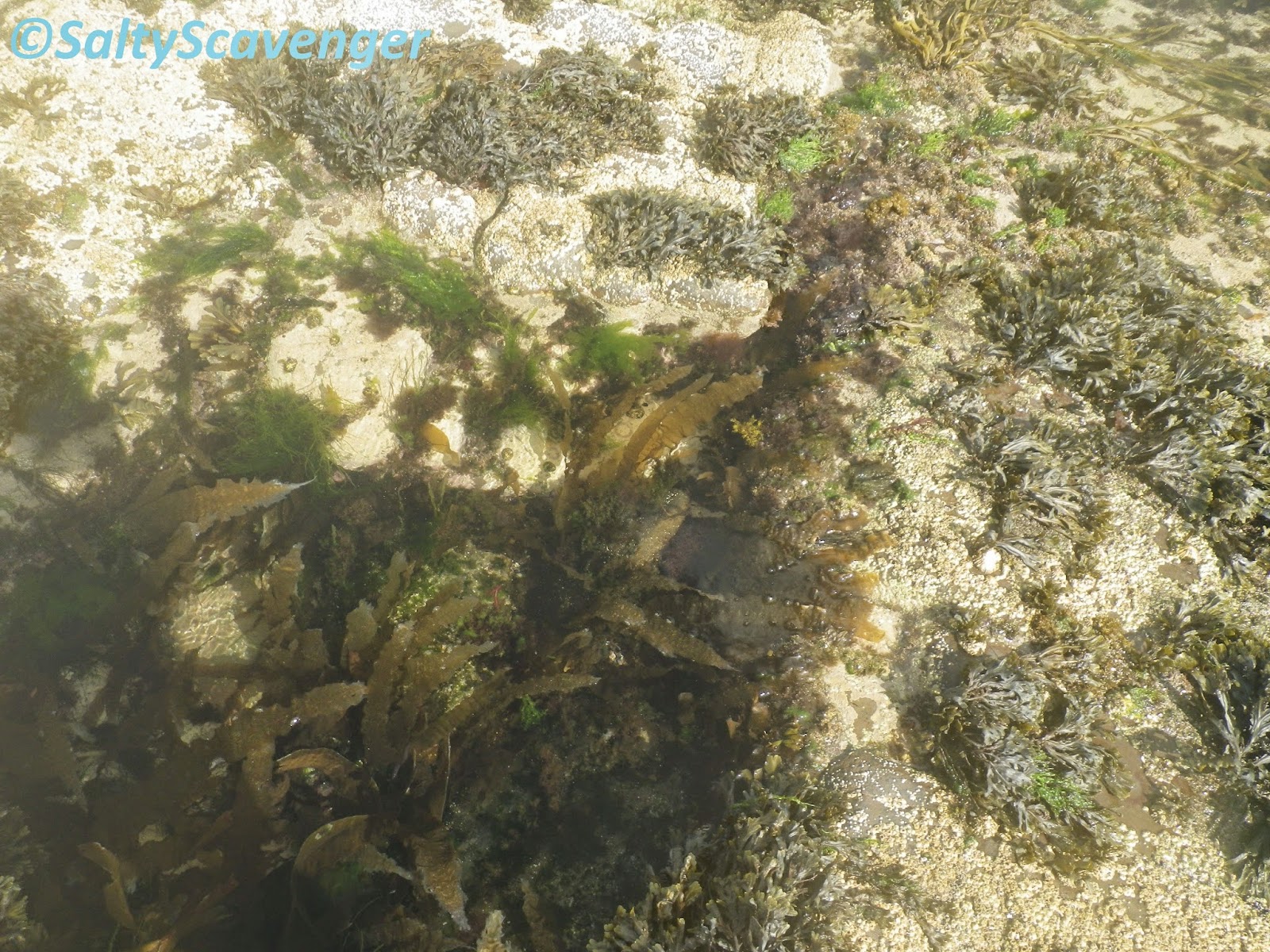The exposed to moderately exposed shore is comprised of sloping bed rock and boulders with crevices, gullies and rockpools. There is freshwater influx from a small waterfall at the base of the cliffs.
Lichens characterise the supralittoral and littoral fringe. Whilst limpets and sparse barnacles charecterise the upper shore with periwinkles throughout both the littoral fringe and upper shore (See previous post).
Rockpools occur from the upper shore down. The majority of which are encrusted with corallinaceae crusts. These coralline rockpools support a variety of fauna depending on their relative size, exposure and position on the shore (See previous post).
Above the rockpools the rock of the upper mid to lower shore is covered in varying abundances of fucoids and barnacles with an array of other organisms within the rock crevices.
Habitat classification:
Substrate
|
LR (Littoral rock)
|
Habitat
|
LR.MLR (Moderate energy littoral
rock)
|
LR.FLR (Features of ilttoral rock)
|
Biotope complex
|
LR.MLR.BF (Barnacles and fucoids on
moderately exposed shores)
|
LR.FLR.Rkp (Rockpools)
|
Biotope
|
LR.MLR.BF.FspiB (Fucus spiralis on
full salinity exposed to moderately exposed upper eulittoral rock)
|
LR.MLR.BF.Fser (Fucus serratus on
moderately exposed eulittoral rock)
|
LR.FLR.Rkp.Cor (Coralline crust
dominated shallow eulittoral rockpools)
|
LR.FLR.Rkp.FK (Fucoids and Kelp in
deep eulittoral rockpools)
|
Sub biotope
|
|
|
LR.FLR.Rkp.Cor.Cor (Corallina
officinalis and coralline crusts in shallow eulittoral rockpools)
|
|
Below are images of organisms you may encounter whilst rockpooling in these habitats:
 |
| The shore is comprised of sloping bed rock and boulders with crevices, gullies and rockpools. |
 |
| Fucoids and barnacles form a patchwork across the shore interspersed with rockpools. Habitat classification: LR.MLR.BF (Barnacles and fucoids on moderately exposed shores). |
 |
| Fucus spiralis occurs in the upper mid shore. Habitat classification: LR.MLR.BF.FspiB (Fucus spiralis on full salinity exposed to moderately exposed upper eulittoral rock) |
 |
A dog whelk (Nucella laupillus).
 |
An edible periwinkle (Littorina littorea).
|
|
 |
| Small individuals of common mussel (Mytilus edulis) occur within crevices. |
 |
| The damp crevices support a variety of organisms including Cladophora sp and limpets. |
 |
Coral weed (Corallina officinalis) overgrows corallinaceae crust in a damp crevice of the shore, surrounded by limpets and barnacles.
 |
A variant of coral weed grows on a limpet.
|
|
 |
A sprintail on the shore.
|
 |
| Barnacles and limpets (Patella vulgata) |
 |
| P. vulgata seek refuge amongst F. spiralis |
 |
| Nucella lapillus |
 |
| Clumps of F. spiralis amongst barnacles and Nucella lapillus. Barnacle density is increased in this section of the shore; and they constitute the major diet of the dog whelks. |
 |
| Clumps of F. spiralis amongst barnacles and Nucella lapillus |
 |
| Clumps of F. spiralis amongst barnacles and Nucella lapillus |
 |
| Beadlet anemones (Actinia equina), barnacles and Nucella lapillus |
 |
A beadlet anemone (Actinia equina)
|
 |
| Small individuals of M. edulis grow amongst the barnacles. |
 |
| Small individuals of M. edulis grow amongst the barnacles. |
 |
| Different sized barnacles represent different cohorts amongst the shore from separate recruitment episodes. |
 |
| Serrated wrack (Fucus serratus) and Thong weed (Himanthalia elongata) occur on the lower shore. Habitat classification: LR.MLR.BF.Fser (Fucus serratus on moderately exposed eulittoral rock) |
 |
Young Fucus serratus, thongweed (Himanthalia elongata)and barnacles on the lower shore.
|
 |
Young growth of Fucus sp.
|
 |
| Seaweed diversity increases down the shore. |
 |
| Thongweed (Himanthalia elongata) |
 |
| Osmundea sp |
 |
A flat periwinkle (Littorina sp) on the lower shore.
|




























































